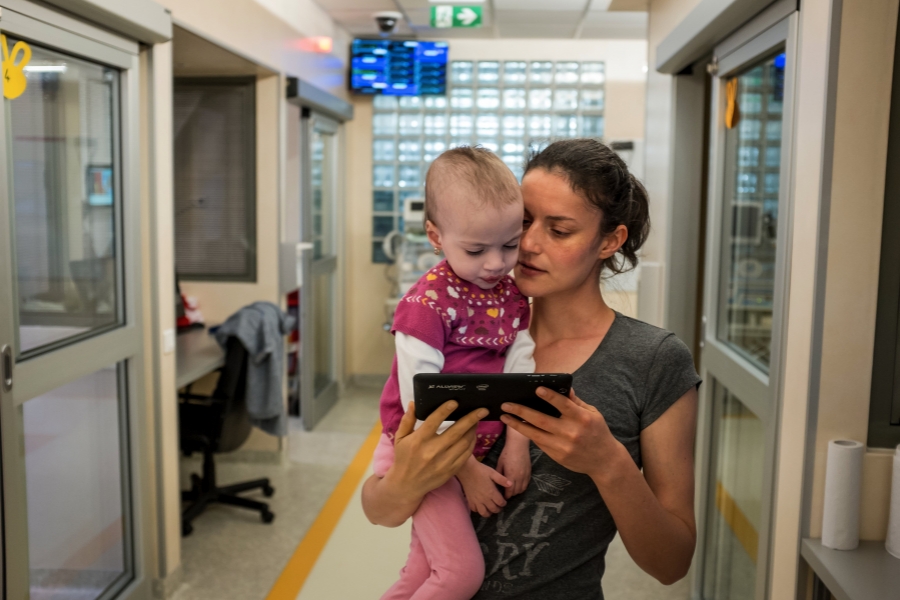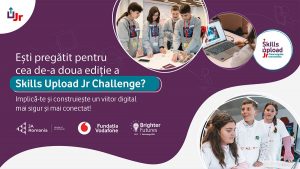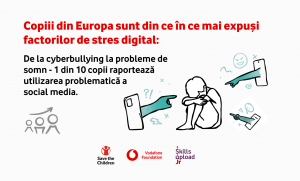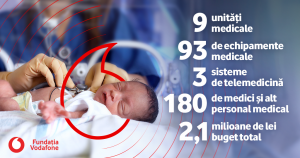At the age of three, Erica is the first child in Romania with the short bowel syndrome to have survived without a transplant. For the past three years, she’s been living in the intensive care ward for new-born babies, at the Marie Curie Hospital in Bucharest. “If the ward would not have been rebuilt in 2013 through the Vodafone Foundation and the Children’s Heart Association, Erica could not have evolved as she did, and her chances to live would have been slimmer”, her mother claims, after having lived in this hospital for the past three years.
Erica was born with just 15 centimeters of functional bowel, compared to 70, for a healthy child, and with a Wolf-Hirschhorn malformation (the palate and the nasal cavity are directly connected). Since she was just three days old, she’s been living at the Children Clinical Emergency Hospital Marie Curie in Bucharest, with her mother Mihaela. Five months after they arrived here, in November 2013, the intensive care ward for new-born babies was rebuilt, becoming the most modern ward of this kind in Eastern Europe. Funded by the Vodafone Romania Foundation and built in partnership with the Children’s Heart Foundation, the new ward has completely changed the way in which babies are treated and monitored. A room for mothers was also brought in, so that the women who want to be closer to their children wouldn’t have to sleep in hospital beds.
Mihaela Bădescu is Erica’s mother (or “mother Bădi”, as the doctors and the nurses call her) and she evolved along with the new ward. She saw the room with all the incubators together turned into 27 individual rooms (“enclosures” for each baby), she saw the old monitoring equipment being replaced with syringe pumps, ultrasound scanners, state-of-the-art cardiographs which render the doctors’ work easier. She received a bed which is not a hospital bed and which makes her life next to Erica easier, because she continues to live with her in the hospital.
We let Mihaela tell us how everything changed and what she and Erica felt along the way.

It was a followed-up pregnancy, from a gynecology and echography perspective, yet no one was able to see any of the future complications. It was an easy pregnancy, I did not have any problems, nausea, I was not sick at all. The first sign that something was wrong was that she was born at 34 weeks. I was 28. Before the eight months checkup, I began to feel a sharp pain, so I arrived at the gynecologist at midnight and I gave birth that night. She was only graded as an 8, she was premature and then, for the first time, the malformation of her little mouth was visible. It was the June 8th, 2013, Friday to Saturday, 2:45 AM.
When I saw her little mouth (“the wolf mouth”), I knew it was just a feeding issue, and that if she managed to pull through, she would be fine, as this would be followed by successive surgeries until the defect would be repaired, but I still wondered why she came so early, because this could not have been the cause of a premature birth.
The next evening, they told me that she had ate, yet she did not have her first stool and that she threw up. In the morning, the radiographies revealed that there was a problem and that the transit was not performed through the intestine, as it should have, and that she wasn’t discharging the food. Afterwards, I found out that, because her bowel was not ok, she started to become infected, as all the toxins were in her blood, instead of being eliminated.
The next day, documents were made for us to come to Bucharest, to Marie Curie. They told me: if they don’t admit you there, there’s nowhere else for us to send you. The new-born ward was overcrowded and they insisted on the phone as we had no other chance. By June 9th she was already hospitalized.
Erica’s prognosis was reticent. During the evening prior to her first surgery, on June 10th, the anesthesiologist told me what would be the easiest and the worst diagnosis. The easiest was volvulus, where a part of the intestine twists and has to be brought back to its normal position. The most severe diagnosis was a volvulus turned into a necrosis which could have destroyed the intestine entirely. In Erica’s case it was worse than the worst. She was left with 15 centimeters of good bowel, out of at least 70, which she should have had.
The first intervention was a jejunostomy. They cut the end of the bowel because it did not reach her tiny bottom, they took it out on the skin somewhere on her tummy and this is where the fecal matter came out, in a tiny bag attached to her tummy. She was left with the two stomas exiting into the little bag and I learned how to remove them myself.
The second intervention was a partialanastomosis consisting of the partial connecting of the bowel. The surgeon told me it was the first time he was doing that and that he didn’t know how it would turn out, but that it would not make her condition worse. The only risk was the actual intervention.
Then, there were the surgeries to her little mouth and a third intervention to her tummy–total anastomosis, when the doctor was able to fully connect the large and the small intestine.
Erica had a catheter put in after the first surgery (2013), until two weeks ago, when she took it out herself. A catheter is a more special cannula. The cannula enters a peripheral, surface vein. The catheter enters a main vein, through the jugular or the inguinal area, going a lot deeper than a cannula and entering the main vein with a greater blood flow. It is preferred for patients with a prolonged treatment, it reaches the heavier blood flow, so that the body can take in the solutions it needs a lot quicker.
Now we are in a trial period, to see if they’re going to put in another catheter or if we’re going home. Her diet is now liquid and semi-liquid. I can’t give her animal proteins, I don’t feed her meat, however, I manage to feed her high calcium cheese and we are testing some yoghurts, maybe dairy products will eventually catch on. She also eats avocado, cereals, quinoa, millets. She also tolerates vegetables very well. Well, we’re doing this food diversification since she was a little over a year, since then, we’ve been struggling to eat different things, but this is done with patience, gradually.
I will never forget the moment when I was told that her chances of survival were minimal and that the 15 centimeters of intestine represented a diagnosis incompatible with life. Nobody talked about miracles or the fact that I should prepare for the worst. Their strategy was “let’s cross that bridge when we get there”. I asked: Are there 100% chances for her not to make it? Will she die? We don’t know. Will she live? We don’t know this either.
“If you tell me that she is going to die, I would like to know that her being born was not in vain, and I know that at this time, organs are very important. So, if it is possible, I agree to donating her organs.” The doctor was listening to me with her eyes wide open. She told me that I was the only mother who said such a thing. I told her: Yes, I might not have Erica, but I want Erica to live in other children who need those organs. She explained to me that in Romania organs are not harvested from children that young. And Erica’s illness, the treatment she has to follow gradually destroys some of her other organs– all the solutions going into her vein were going straight to her liver: proteins, amino acids, minerals, calcium and glucoses.
Now, Erica is no longer subject to an imminent risk. However, being in intensive care, it can happen. We don’t exclude any risk, I don’t know which direction things will evolve towards. It is exclusively up to her and her strength to carry on.
*
When I got here, in June 2013, the old ward was really tiny. It was a quarter of its current size, maybe even less. It was just a hallway, with the entire treatment and milk side, then a septic patient room and then all the other incubators – 11-12 incubators placed next to each other. With mothers who were either breastfeeding or resting or simply staying by their children. With visitors, doctors, nurses, caregivers and the incubators humming. At first, Erica was still in the incubator. When she became bigger she was moved to the radiant warmer–a kind of open incubator, without a lid on top. It was our little community, all crammed there, all over the place.
The worst thing was when a child went into cardiac arrest, needing certain maneuvers or the insertion of a catheter, because then, everyone had to leave the room. The place needed to be sterile, not full of people. These images remain on you like a fingerprint. Nurses and doctors are right to tell mothers that it’s best for them not to witness certain maneuvers. However, sometimes you have to be there to calm your child down. But I wish I had not witnessed many of them. In the room with all the incubators, the most shocking moments where those involving aspiration on children. This is performed with special probes and although the tiny bugs enjoyed being massaged by the nurses to have their mucus removed, the noise they made when striking the child was shocking. But you got used to this and ended up willingly witnessing these things. The insertion of a cannula is also very heartbreaking. They are the size of a fist, they’re premature, tiny, you see them in pain and suffering and so on and this is not easy to handle.
When there were tragic events, they were trying to isolate the incubator with some side guards. We saw the monitor, we were looking at them like at soap operas and we knew exactly what was happening. You get emotionally charged when you see a tiny human who tried and wanted, but it was not possible. You feel the pain of the parents, the doctors, the nurses who all tried. They do their best here for all the children, all of them are treated until the last second as if they were going home. They don’t make the assumption that “they’re not going to make it anyway, so let’s keep them as long as we can, they’ll pass away anyhow and we’re not going to do this”.
*
From the equipment perspective, as far as I know, in the old ward there weren’t as many fans and radiant warmers. Some of them malfunctioned all the time and were put aside, but, as there were babies coming in and in need of help, the faulty ones were also brought in for short periods. For the last three years, there’s been the constant issue of slots, they are never enough. I have never seen in three years an empty enclosure for more than 12hours, and this only if the baby who is supposed to occupy it comes in late due to bureaucracy. The hallway is also rarely empty, without incubators.
Also, aspects related to child supervision are different. Before, there was that shared room where, if you looked around, you could see everyone. After the room was expanded and each child was assigned his/her own enclosure, the risk of infections and bacteria contamination decreased. There was a significant investment in technology and surveillance, temperature, surveillance cameras, communication through various programs with international teams, when an intervention is made. As far as I know, doctors can use a main panel for surveillance, at any time. Even if they discuss the cases of each child, they can have the close-up of that child, at that exact second, to observe him/her. Very, very important with the separation of the enclosures is that when a child has visitors, the infection risk for the little patients is lower, because the visitors are told: see this child from here, from the hallway, because it’s not advisable to go in
In the area of the apparatuses, when I came into the ward, there was a radiograph which seemed to be from the war era. The current one is a lot more advanced, even the radiology staff sometimes comes with the manual around it to see what it can do. They even had a course in the meeting room. Very important, for the building structure side, down, on ground floor, there’s a meeting, conference room, used to hold courses of all types, for the personnel from here and from the hospital. They are properly detailed, well thought, done once and forever.
Erica needed many apparatuses after the first intervention, when we were still on the old therapy, in the smaller room. She was ventilated, she needed syringe pumps, perfusion pumps, transfusion pump, surveillance and monitoring for her respiratory rate, for her heart. After the following interventions, she needed a ventilator, but solely for protection purposes, to support her recovery. The syringe pumps are those used to install the syringes with the treatment. The pumps are used to provide the perfusions with a certain rhythm when entering the vein. The treatment list also became shorter and shorter. The same with the label on the perfusion. The nurses write every day what needs to be put in the perfusion bag, how much glucose, minerals, calcium and this is how the mommy also finds out what’s being put into her child and how much goes in.
With disinfectants, from the beginning, the protocol is: when entering the ward, one must put on gloves, a coat, hands must be washed when going in, when going out, thousands of times. There’s also the climate aspect: here, inside the ward, the windows are not open. When you go in, you don’t feel a stale and foul air, because the ventilation side is working properly and even if the temperature outside is 40 degrees, here, there’s a constant temperature of 20-21 degrees. It is not a proper environment for the development of bacteria and parasites.
*
The private space between us has changed. We had a lot more privacy. These machines beep (syringe pumps, pumps, ventilators), and Erica needed peace and quiet, to be able to rest. You couldn’t stay in the shared space and there were also other mothers who needed space. You had no choice, you had to leave. Here, in these enclosures, things have changed, because I was able to stay as long as I wanted, as long as I could, and I was able to decorate the place, for her to not see that she is in intensive care, to not feel the coldness, where everything beeps and everything is grey. We tried recreate as much as possible her room at home, with little toys, everything. During the three winters that we spent here, we made a little Christmas tree on the wall, we glued tinsel and decorations, the lights were her ultimate delight.
The mothers caring for the new-born babies did not have a properly determined place in the old ward, they were hospitalized due to the kindness of the doctors taking care of the children, mainly in the surgery ward. You had to stay in a bed in their ward, a bed which could have been used for treating another child. So your child was occupying a place downstairs, in the new-born section, while you took another place in the ward upstairs. It was pretty difficult. For nine months I slept in the hospital.
The room for mommies was ready five months after the opening of the new ward. There are four bunk beds, so eight places. There’s also a bathroom and next to it, there’s a kitchen with fridges, a microwave oven, cabinets, tableware and so on. We used to have a bathroom before, and access to all facilities, but you couldn’t eat properly, you couldn’t rest properly, not with the sick children. One was crying, one was sleeping. You couldn’t eat in front of a child because he/she was supposed to go into surgery, you couldn’t eat in front of another child, because he/she had just come out of surgery and was not allowed to eat. I came back from my little one and it was treatment time within the upstairs ward, so the children were screaming from all angles. The fact that this special room was built for mothers was a godsend.
When we got here, Erica was one day old. They took her out of the diapers, got her dressed in a pair of pants which could fit her entire body and a little blouse and they told us: Mommy, take the child and follow us. Two left hands is an understatement. I had no idea how to grab her, how to pick her up, how to handle her. Especially since we were still in the hospital and with problems and I didn’t want to harm her. Sometimes I get flashbacks from the beginning. The desperation returns when you feel powerless. You try and you wish more and more, but you can’t. I remember that each time, even if she wasn’t able to communicate, if I was next to her and got depressed, she did something to remind me: You know, actually you have other things to do. She would move an arm, whine, smile, blink. She did something to take me out of that state of mind and this is what I was telling those at home: I don’t know how much I’m supporting her, but she’s definitely supporting me. She has taught me the most important lesson, that existing without living is in vain. And if she wanted and fought against all odds and against her fate and made it to this point, it is clear that life is worth living from all points of view.




